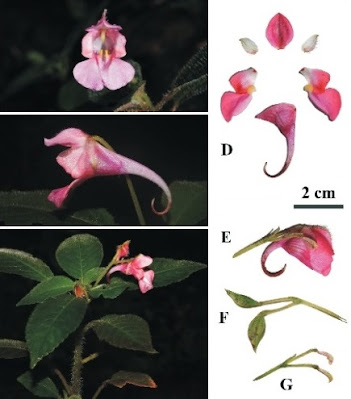[Most Recent Entries] [Calendar View]
Sunday, October 31st, 2021
| Time | Event | ||||
| 12:04a | [Botany • 2021] Cirsium taiwanense (Asteraceae) • A New Species of Cirsium (sect. Onotrophe, subsect. Australicirsium) from Taiwan
Abstract A new species of Cirsium, Cirsium taiwanense Y.H.Tseng & Chih Y.Chang from central-northern Taiwan is reported in this article. This species is similar to C. hosokawae Kitam. in having a densely cobwebby abaxial leaf surface, but differs in its yellow (vs. vivid purplish red) corolla and the angle between the midrib and the lateral veins of the leaf, which is acute as opposed to nearly at a right angle in C. hosokawae. Cirsium taiwanense has 2n = 32 chromosomes, which is different from the other species in the Taiwanese subsect. Australicirsium Kitam. (2n = 34). An identification key to the Cirsium taxa of Taiwan is presented. Keywords: Australicirsium Kitam., central-northern Taiwan, Cirsium, karyotype analysis, pollen morphology,
Cirsium taiwanense Y.H.Tseng & Chih Y.Chang, sp. nov. Diagnosis: Differs from C. hosokawae in having a yellow corolla (vs. vivid purplish red corolla), a narrower angle between the midrib and lateral veins of the cauline leaves ((44–)52–73° vs. 82–90°), and usually more florets (101–135(–194) vs. 54–111) and phyllaries (90–127 vs. 68–109) per capitulum. Differs from C. arisanense by its nodding mature capitula (vs. erect), erect corolla lobes (vs. revolute), and a densely cobwebby abaxial leaf surface (vs. without cobwebby indumentum). Distribution and habitat: Endemic species of Taiwan. Cirsium taiwanense grows in open areas between Querus forest and Abies forest at 1400–3400 m a.s.l. in central-northern Taiwan. Cirsium taiwanense usually grows at sunny sites. Common companion species are Artemisia morrisonensis Hayata (Compositae), Lilium formosanum Wallace (Liliaceae), Salix fulvopubescens Hayata (Salicaceae) and Rubus pectinellus Maxim. (Rosaceae). Chinese name: Tai-wan-ji (臺灣薊). Chih-Yi Chang, Hsy-Yu Tzeng and Yen-Hsueh Tseng. 2021. Cirsium taiwanense (Compositae, Cirsium sect. Onotrophe, subsect. Australicirsium), A New Species from Taiwan. PhytoKeys. 183: 35-53. DOI: 10.3897/phytokeys.183.70119 | ||||
| 12:53a | [Botany • 2021] Cymbilabia sourioudongii (Araceae) • A New Species from Lao PDR
Abstract Cymbilabia sourioudongii, a new species of epiphytic orchid is described and illustrated from Phou Khao Khouay National Protected Area of Laos PDR. Keywords: Illegal orchid trade, New species, Phou Khao Khouay National Protected Area, Vandopsis. Cymbilabia sourioudongii Souvann. & Lanors., sp. nov. Similar to C. undulata but differs in having a more compact habit, narrowly elliptic-oblong to lanceolate leaves that are 2–3.7 cm long and 0.8–1.7 cm wide (vs. oblong, 9–15 cm long and 1.5–3 cm wide), smaller sepals and petals that are 7–18 mm long and 3–8 mm wide (vs. 24–40 mm long and 8–14 mm wide), a shorter labellum that is 5–9 mm long, which has semi-orbiculate side lobes (vs. 15–20 mm long with sub-ovate to triangular side lobes), a verrucose epichile (vs. muricate with papillae). Habitat: Growing on small trees and boulders in full sun in mixed semi-deciduous broad-leaved and coniferous forest at around 1100 m elevation. Distribution: Cymbilabia sourioudongii is so far known only from the type locality in Phou Khao Khouay National Protected Area in Bolikhamxai province, central Laos. Etymology: The name for this species honors His Excellency Dr. Sourioudong Sundara, Vice Minister of Education and Sport, Lao PDR, who is an experienced scientific researcher of Lao PDR. Vernacular name: Ueang Sor Mouang ເອື້ອງຊໍ່ມ່ວງ (Purple flower orchid). Souvannakhoummane K., Lanorsavanh S., Rakthai P., Kumar P. and S.W. Gale. 2021. Cymbilabia sourioudongii (Orchidaceae), A New Species from Lao PDR. RHEEDEA: Journal of the Indian Association for Angiosperm Taxonomy. 31(3); 186–190. Rheedea.in/journal/eT2qVxA1 ທີມງານນັກຄົ້ນຄວ້າ ວິທະຍາສາດ ຈາກມະຫາວິທະຍາໄລແຫ່ງຊາດ ທີ່ໄດ້ຄົ້ນພົບ ດອກເຜີ້ງຊະນິດໃໝ່ຂອງໂລກ ຄົ້ນພົບຢູ່ເຂດປ່າສະຫງວນແຫ່ງຊາດ ພູເຂົາຄວາຍ ຢູ່ ສປປ ລາວ ໄດ້ໃຫ້ກຽດ ນໍາເອົາ ຊື່ຂອງທ່ານ ປອ. ສຸລິອຸດົງ ສຸນດາລາ (Dr. Sourioudong Sundara), ອາດີດ ອາຈານສອນ ແລະ ນັກຄົ້ນຄວ້າ ທາງດ້ານ ວິທະຍາສາດ Biotechnology ຢູ່ມະຫາວິທະຍາໄລແຫ່ງຊາດ ຜູ້ນໍາພາທີມນັກສຶກສາ ຄົ້ນຄວ້າກ່ຽວກັບດອກເຜິ້ງປ່າ, ປະຈຸບັນ ເປັນ ຮອງລັດຖະມົນຕີກະຊວງສຶກສາທິການ ແລະ ກິລາ, ມາຕັ້ງເປັນຊື່ວິທະຍາສາດດອກເຜິ້ງຊະນິດໃໝ່ຂອ | ||||
| 12:55a | [Botany • 2020] Impatiens quintadecimacopii (Balsaminaceae) • A New Species and A Newly Recorded Species of Impatiens from Yunnan, China
Abstract Impatiens quintadecimacopii G. W. Hu & Q. F. Wang sp. nov. is described and I. porrecta is reported as a new record from southwestern Yunnan province of China. These two species are close in morphology but can be distinguished by color of flowers, shape of lateral sepals and upper petals, and color of capsules. Morphological characters of these two species indicate they belong to sect. Uniflora in I. subg. Impatiens. Phylogenetic analysis of a combined dataset from nuclear ITS and plastid atpB-rbcL sequences confirmed their close relationship and their phylogenetic placement in sect. Uniflora. Key words: Impatiens, New species, New record, Phylogeny, Taxonomy, China Impatiens quintadecimacopii G. W. Hu & Q. F. Wang sp. nov. Etymology: The specific epithet "quintadecimacopii" is derived from the Fifteenth Meeting of the Conference of the Parties of the United Nations Convention on Biological Diversity (CBD COP15). This species is named for this upcoming conference which will be hold in Kunming, Yunnan, China in 2021. Zhang Cai-Fei, Peng Shuai, Tian Jing, Hu Guang-Wan and Wang Qing-Feng. 2020. A New Species and A Newly Recorded Species of Impatiens (Balsaminaceae) from Yunnan, China. Plant Science Journal. 38 (4); 437-447. DOI: 10.11913/PSJ.2095-0837.2020.40437 |
| << Previous Day |
2021/10/31 [Calendar] |
Next Day >> |



















